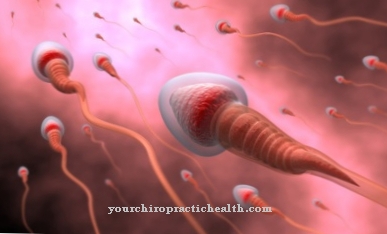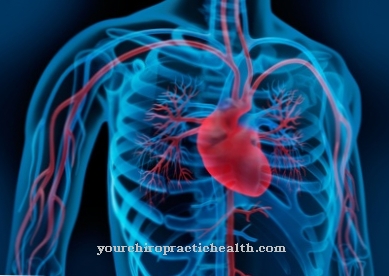With the term Blood volume is the total amount of blood in the body. The blood volume consists of the volume of the blood plasma and the volume of the cellular blood components.
What is the blood volume?

The total amount of blood in the body is called blood volume. The blood can be divided into two parts. First, there is the plasma volume. It corresponds to the volume of blood without the blood cells. Around 55 percent of the blood consists of blood plasma. 90 percent of the blood plasma consists of water. The remaining 10 percent consists of dissolved substances. Important solutes include electrolytes such as sodium, chloride, potassium, calcium, magnesium, bicarbonate, and phosphates.
Plasma proteins such as albumin, lipoproteins, immunoglobulins and fibrinogen are also components of the blood plasma. The blood plasma also contains hormones and nutrients such as glucose. Decomposition products from the metabolism are also found in the blood plasma. These include pyruvate, creatinine, creatine, uric acid, and lactate.
45 percent of the blood volume is made up of corpuscular components. Three cell types can be distinguished in terms of the cellular components: red blood cells (erythrocytes), white blood cells (leukocytes) and thrombocytes (blood platelets). With four to five million cells per µl of blood, the red blood cells make up by far the largest proportion. With 150,000 to 300,000 cells, the thrombocytes form the second largest fraction. In contrast, there are only 4,000 to 9,000 leukocytes per µl.
Overall, the blood volume in adults is four to six liters. For women, 61 milliliters of blood can be expected per kilogram of body weight. In men, it is an average of 70 milliliters per kilogram of body weight. Depending on the organ or compartment, the blood volume can be divided into cerebral, pulmonary, intrathoracic, extrathoracic, venous and arterial blood volume. The volume of blood that the heart pumps through the body's circulation every minute is called the cardiac output.
Function & task
The blood volume can also be broken down according to functional aspects. The central blood volume is that portion of the blood volume that is located in the area between the pulmonary valve and the aortic valve of the heart. The central blood volume is therefore the blood volume of the left atrium, the right ventricle and the pulmonary circulation.
The central blood volume is a decisive control variable for the central venous pressure. The central venous pressure is the venous blood pressure measured on the central venous catheter. The central blood volume also serves as a blood depot for the left ventricle. If there is a disproportion between the pumping capacity of the two heart chambers, the blood depot can quickly increase the ejection capacity of the left ventricle so that the disproportion can be compensated.
The circulating blood volume is the volume of blood that is actually in circulation at the moment. Part of the blood volume is in the low pressure system and another is used as a blood reservoir. The circulating blood volume is primarily used to transport substances. The blood carries nutrients, vitamins and oxygen to the body cells. At the same time, it transports pollutants or metabolic end products from the cells to the excretory organs. Hormones also get from the production site to the target cells via the circulating blood volume. The circulating blood volume also plays a role in defense against infection. With the circulating blood, the white blood cells get to places of infection.
The peripheral blood volume is in the periphery of the body. Due to the heat capacity, the peripheral blood volume is of particular importance in maintaining the body temperature. A sufficient and constant blood volume also plays an important role in maintaining blood pressure in the vessels. Without a constant blood volume, organs and tissues cannot be supplied with oxygen or nutrients.
Illnesses & ailments
A decrease in blood volume is known as a volume contraction. The blood volume can decrease due to dehydration. Dehydration can be caused either by insufficient intake of fluids or by pathologically increased fluid loss. Kidney diseases, high fever, breastfeeding, diarrhea and vomiting can result in severe fluid loss.
An excessive decrease in blood volume is noticeable by thirst, dryness of the skin and mucous membranes and by decreased urine output. Low blood pressure is also a characteristic symptom of dehydration. If 12 to 15 percent of the body fluid is lost, hypovolemic shock occurs. However, hypovolemic shock can also have other causes.
Fluid can be lost in large-scale burns, for example. Hemorrhagic shock is also hypovolemic shock. Hemorrhagic shock is caused by bleeding within the body. Hemorrhagic shock often occurs after gastrointestinal bleeding. A traumatic hemorrhagic shock is a hemorrhagic shock that occurs as a result of a traumatic impact. Due to the severe loss of fluid, the amount of circulating blood volume decreases.
A blood loss of one liter can still be compensated. The arterial blood pressure remains largely normal. With greater fluid loss, blood pressure drops. In the early stages of hypovolemic shock, blood pressure is still normal. The skin is cool, moist, and pale. In the second stage, the stage of incipient decompensation, the systolic blood pressure drops to less than 100 mmHg. The neck veins have collapsed, the patient is very thirsty, and the urine output is greatly reduced. In the third stage, the systolic blood pressure is below 60 mmHg. The pulse can hardly be felt and breathing is shallow. The patients pass out. The kidney function fails completely. The hypovolemic shock must be treated in intensive care as soon as possible. Otherwise it can be fatal.



























